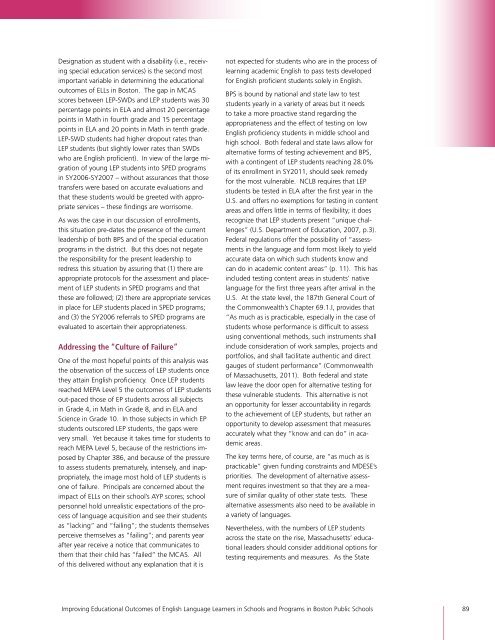Full Report - Center for Collaborative Education
Full Report - Center for Collaborative Education
Full Report - Center for Collaborative Education
Create successful ePaper yourself
Turn your PDF publications into a flip-book with our unique Google optimized e-Paper software.
Designation as student with a disability (i.e., receiving<br />
special education services) is the second most<br />
important variable in determining the educational<br />
outcomes of ELLs in Boston. The gap in MCAS<br />
scores between LEP-SWDs and LEP students was 30<br />
percentage points in ELA and almost 20 percentage<br />
points in Math in fourth grade and 15 percentage<br />
points in ELA and 20 points in Math in tenth grade.<br />
LEP-SWD students had higher dropout rates than<br />
LEP students (but slightly lower rates than SWDs<br />
who are English proficient). In view of the large migration<br />
of young LEP students into SPED programs<br />
in SY2006-SY2007 – without assurances that those<br />
transfers were based on accurate evaluations and<br />
that these students would be greeted with appropriate<br />
services – these findings are worrisome.<br />
As was the case in our discussion of enrollments,<br />
this situation pre-dates the presence of the current<br />
leadership of both BPS and of the special education<br />
programs in the district. But this does not negate<br />
the responsibility <strong>for</strong> the present leadership to<br />
redress this situation by assuring that (1) there are<br />
appropriate protocols <strong>for</strong> the assessment and placement<br />
of LEP students in SPED programs and that<br />
these are followed; (2) there are appropriate services<br />
in place <strong>for</strong> LEP students placed in SPED programs;<br />
and (3) the SY2006 referrals to SPED programs are<br />
evaluated to ascertain their appropriateness.<br />
Addressing the “Culture of Failure”<br />
One of the most hopeful points of this analysis was<br />
the observation of the success of LEP students once<br />
they attain English proficiency. Once LEP students<br />
reached MEPA Level 5 the outcomes of LEP students<br />
out-paced those of EP students across all subjects<br />
in Grade 4, in Math in Grade 8, and in ELA and<br />
Science in Grade 10. In those subjects in which EP<br />
students outscored LEP students, the gaps were<br />
very small. Yet because it takes time <strong>for</strong> students to<br />
reach MEPA Level 5, because of the restrictions imposed<br />
by Chapter 386, and because of the pressure<br />
to assess students prematurely, intensely, and inappropriately,<br />
the image most hold of LEP students is<br />
one of failure. Principals are concerned about the<br />
impact of ELLs on their school’s AYP scores; school<br />
personnel hold unrealistic expectations of the process<br />
of language acquisition and see their students<br />
as “lacking” and “failing”; the students themselves<br />
perceive themselves as “failing”; and parents year<br />
after year receive a notice that communicates to<br />
them that their child has “failed” the MCAS. All<br />
of this delivered without any explanation that it is<br />
not expected <strong>for</strong> students who are in the process of<br />
learning academic English to pass tests developed<br />
<strong>for</strong> English proficient students solely in English.<br />
BPS is bound by national and state law to test<br />
students yearly in a variety of areas but it needs<br />
to take a more proactive stand regarding the<br />
appropriateness and the effect of testing on low<br />
English proficiency students in middle school and<br />
high school. Both federal and state laws allow <strong>for</strong><br />
alternative <strong>for</strong>ms of testing achievement and BPS,<br />
with a contingent of LEP students reaching 28.0%<br />
of its enrollment in SY2011, should seek remedy<br />
<strong>for</strong> the most vulnerable. NCLB requires that LEP<br />
students be tested in ELA after the first year in the<br />
U.S. and offers no exemptions <strong>for</strong> testing in content<br />
areas and offers little in terms of flexibility; it does<br />
recognize that LEP students present “unique challenges”<br />
(U.S. Department of <strong>Education</strong>, 2007, p.3).<br />
Federal regulations offer the possibility of “assessments<br />
in the language and <strong>for</strong>m most likely to yield<br />
accurate data on which such students know and<br />
can do in academic content areas” (p. 11). This has<br />
included testing content areas in students’ native<br />
language <strong>for</strong> the first three years after arrival in the<br />
U.S. At the state level, the 187th General Court of<br />
the Commonwealth’s Chapter 69.1.I, provides that<br />
“As much as is practicable, especially in the case of<br />
students whose per<strong>for</strong>mance is difficult to assess<br />
using conventional methods, such instruments shall<br />
include consideration of work samples, projects and<br />
portfolios, and shall facilitate authentic and direct<br />
gauges of student per<strong>for</strong>mance” (Commonwealth<br />
of Massachusetts, 2011). Both federal and state<br />
law leave the door open <strong>for</strong> alternative testing <strong>for</strong><br />
these vulnerable students. This alternative is not<br />
an opportunity <strong>for</strong> lesser accountability in regards<br />
to the achievement of LEP students, but rather an<br />
opportunity to develop assessment that measures<br />
accurately what they “know and can do” in academic<br />
areas.<br />
The key terms here, of course, are “as much as is<br />
practicable” given funding constraints and MDESE’s<br />
priorities. The development of alternative assessment<br />
requires investment so that they are a measure<br />
of similar quality of other state tests. These<br />
alternative assessments also need to be available in<br />
a variety of languages.<br />
Nevertheless, with the numbers of LEP students<br />
across the state on the rise, Massachusetts’ educational<br />
leaders should consider additional options <strong>for</strong><br />
testing requirements and measures. As the State<br />
Improving <strong>Education</strong>al Outcomes of English Language Learners in Schools and Programs in Boston Public Schools 89


